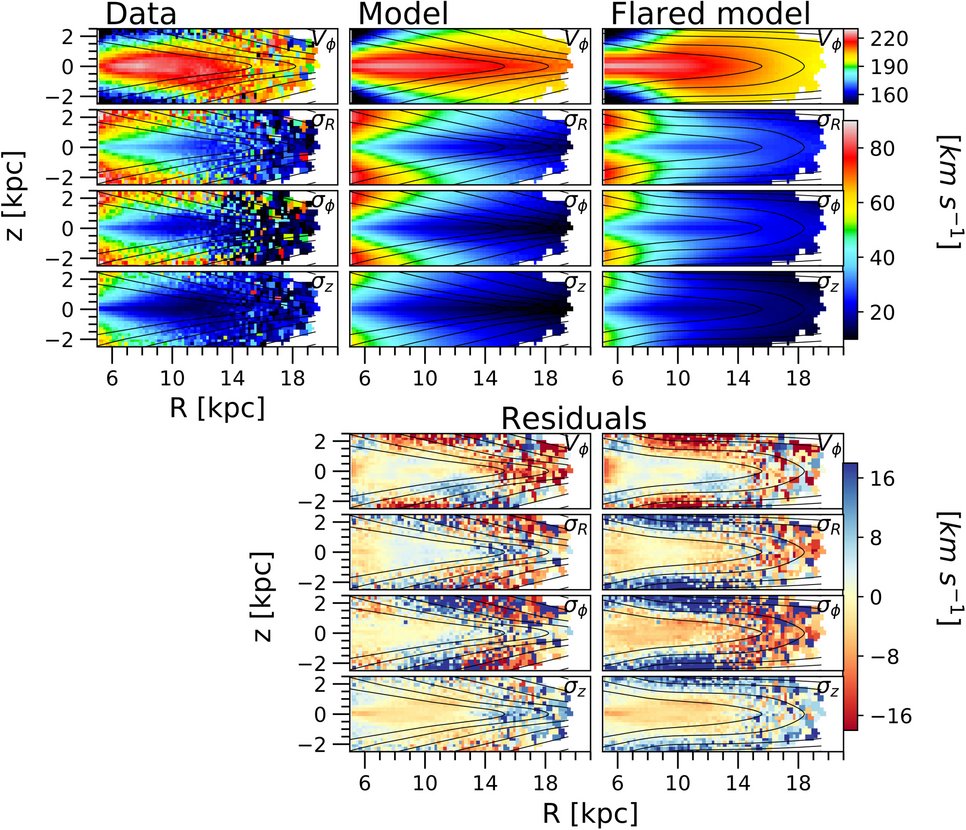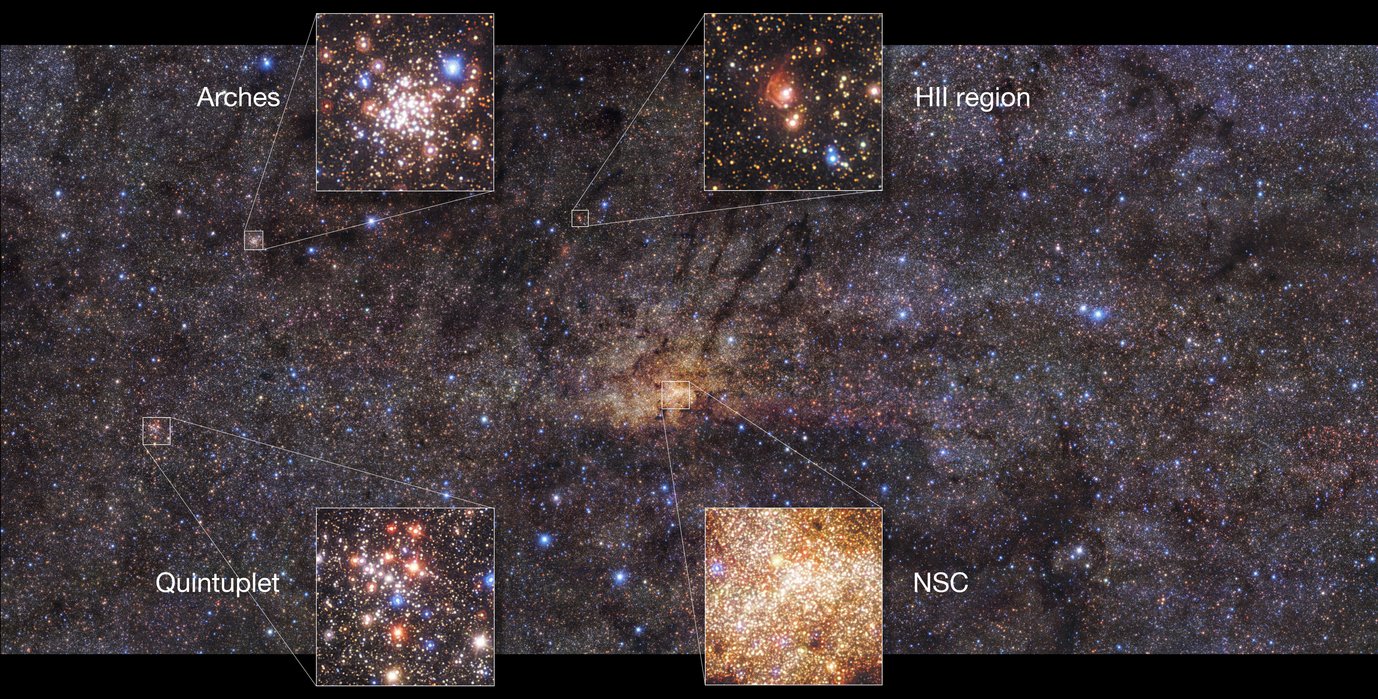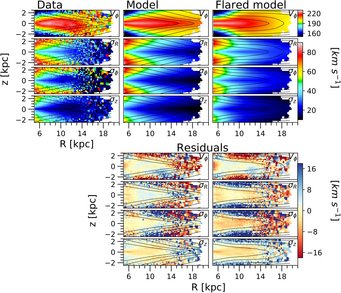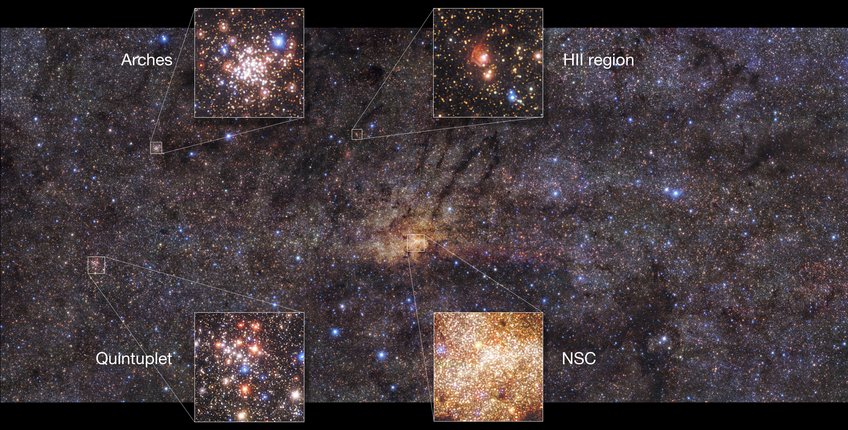
The Milky Way

with a flared disk. The bottom two panels show the residuals (data-model) for the two models and from top to bottom, the rows show colourcoded the v_phi, sigma_R, sigma_phi, and sigma_z values. The black lines are the
stellar density contours.
The Figure is adapted from Nitschai et al. (2021): https://ui.adsabs.harvard.edu/abs/2021ApJ.
Dynamical models are crucial for our understanding of galaxies, but for most galaxies the models suffer from degeneracies because of limited data. For our own Galaxy however we can do observations in great detail and there have been many high precision surveys in the past years, such as Gaia (Gaia Collaboration et al., 2016) and APOGEE (Allende Prieto et al., 2008 & Majewski et al., 2017). In this work we investigate the Milky Way disk using these surveys and the spherically aligned Jeans anisotropic method (JAM, Cappellari, 2020). This allows us to constrain the gravitational potential, the mass distribution, circular velocity and dark matter density of our Galaxy.
Data: Gaia DR2, Gaia EDR3, Hogg et al., 2019
Dynamical modelling: results have been published in Nitschai et al. (2020) and Nitschai et al. (2021).
For more information, please contact Selina Nitschai.

The Milky Way’s centre is the closest galactic nucleus, and the only one where we are able to resolve individual stars down to milli-parsec scales, being thus of fundamental astrophysical interest to understand galactic nuclei and their role in galaxy evolution. It is characterised by extreme conditions, such as high stellar densities, strong tidal fields, high magnetic fields, and high turbulence and temperature of the interstellar medium. In spite of - or possibly because of - these harsh conditions, it is the most prolific star forming region of the Galaxy averaged over volume. The presence of HII regions, massive young stars, massive young clusters (a few 104 , like the Arches, Quintuplet and the nuclear star cluster), as well as an overabundance of luminous giants, provide evidence for recent star formation throughout the Galactic centre. Therefore, it is also a unique laboratory to study star formation under extreme conditions.
Using near infrared data to overcome the extreme extinction, we are characterising the star formation history, the stellar population, and the formation process of the nuclear bulge of the Milky Way (Nogueras-Lara et al., 2020a). Moreover, analysing the complex line-of-sight towards the Galactic centre allows us to characterise the extinction curve in the near infrared (Nogueras-Lara et al., 2020b & Nogueras-Lara et al., 2021a), and understand the structure of the Milky Way’s spiral arms in a region that is blind to the Gaia survey (Nogueras-Lara et al., 2021b).
For more information, please contact Francisco Nogueras-Lara.
![a) Map of red giant stars in the Milky Way nuclear star cluster, colour-coded by their metallicity [M/H]. Dark blue denotes low [M/H], light blue high [M/H]. b) Same area as in a), but the colours denote the mean line-of-sight velocities (in km/s) of the closest 15 stars per pixel.](/5836976/original-1646032956.jpg?t=eyJ3aWR0aCI6MTM3OCwib2JqX2lkIjo1ODM2OTc2fQ%3D%3D--f87720dc4d34a641d22225d00e4c968b457646ca)
b) Same area as in a), but the colours denote the mean line-of-sight velocities (in km/s) of the closest 15 stars per pixel.
Nuclear star clusters (NSCs) are common objects in nearby galaxies. They are dense stellar systems, located at the center of galaxies. Because the Milky Way NSC is at a distance of only 8 kpc, we can spatially resolve its stellar populations and kinematics much better than in external galaxies. This makes it a reference object for understanding the structure and assembly history of all NSCs.
Anja studies the stellar kinematics of the Milky Way NSC in integrated light towards the half-light radius (4.2pc).
She runs axisymmetric Jeans models and triaxial Schwarzschild models to understand the large-scale kinematics of the Milky Way NSC.
With near-infrared K-band spectroscopy of single resolved stars obtained with KMOS (VLT), Anja studies the star formation history and metallicity distribution of the Milky Way NSC. The data extend to a larger spatial scale than previous stellar populations studies of the Galactic centre. The dashed circle denotes the effective radius at 4.2 pc.
The mean metallicity of stars in the NSC is super-solar, though there is a wide range of metallicities.
In the Galactic North and East of the NSC, the fraction of stars with sub-solar metallicity is ~30%, but only ~10% in the Galactic South.
For more information, please contact Anja Feldmeier-Krause.


![a) Map of red giant stars in the Milky Way nuclear star cluster, colour-coded by their metallicity [M/H]. Dark blue denotes low [M/H], light blue high [M/H]. b) Same area as in a), but the colours denote the mean line-of-sight velocities (in km/s) of the closest 15 stars per pixel. a) Map of red giant stars in the Milky Way nuclear star cluster, colour-coded by their metallicity [M/H]. Dark blue denotes low [M/H], light blue high [M/H]. b) Same area as in a), but the colours denote the mean line-of-sight velocities (in km/s) of the closest 15 stars per pixel.](/5836976/original-1646032956.jpg?t=eyJ3aWR0aCI6ODQ4LCJmaWxlX2V4dGVuc2lvbiI6ImpwZyIsIm9ial9pZCI6NTgzNjk3Nn0%3D--df0a1c391675efacfb294e1fa390252abee01564)